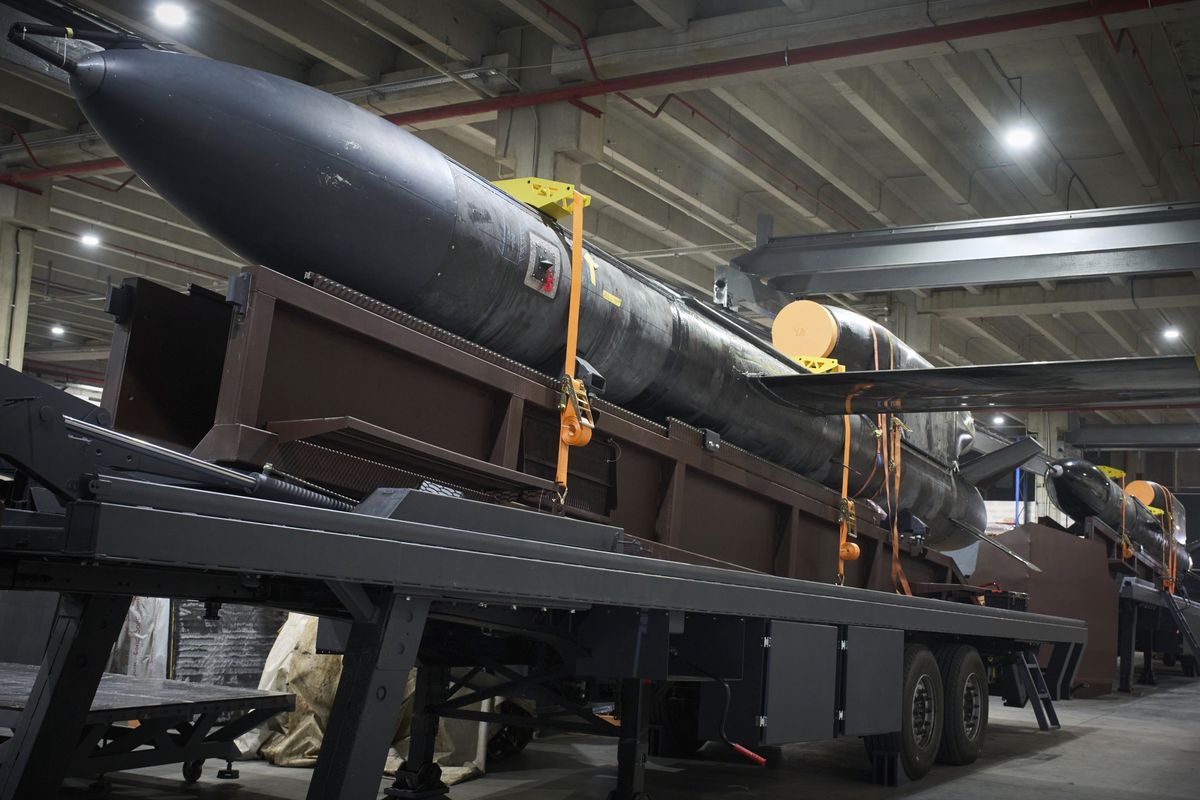SUBSCRIBER+EXCLUSIVE REPORTING — The future of Ukraine may depend on a single word from the United States: “Yes.” That’s the answer Ukraine is seeking from the U.S. after asking repeatedly for permission to use ATACMS missile systems against targets inside Russia.
Ukrainian President Volodymyr Zelensky made the ask again this week in an interview with The New York Times, arguing that the only way to stop Russian attacks on Ukraine was to use Western-supplied weapons against troops, weapons and logistics centers in Russia.
“How do we respond when they strike our cities?” Zelensky asked. He said Ukrainian troops had clear visibility of Russian forces massing across the border, but were powerless to strike them. “They proceed calmly,” he said of the Russians, “understanding that our partners do not give us permission” to use their weapons to strike back.
Ever since Russia’s February 2022 invasion of Ukraine, it’s been a red-line condition for all U.S. military aid: it cannot be used against targets inside Russia. The fear has been that attacks on Russian soil with American weapons could create an uncontrollable escalation of the war. But now, as Ukraine struggles to recapture battlefield momentum, Ukrainian commanders — and observers and supporters in the U.S. — say that without a “yes” from Washington, they may lose the war.
“Bottom line: If you want to help Ukraine defeat the Russians, you cannot let (the Russians) have their territory as a sanctuary,” Philip Wasielewski, a former National Security Council official and now a Senior Fellow at the Foreign Policy Research Institute, told The Cipher Brief.
On Monday, Lithuanian Foreign Minister Gabrielius Landsbergis chimed in, saying it was a “mistake” to keep Ukraine from using Western-supplied weapons to strike targets within Russian territory.
“The Ukrainians must be allowed to use the equipment provided to them so that they can achieve strategic objectives,” Landsbergis said. "From the beginning, we have made the mistake of limiting the Ukrainians because it could be seen as an escalation.”
The U.S.-supplied ATACMS missiles, which can fly up to 300 kilometers (180 miles), represent one of the few means Ukraine has, apart from long-range drones, to attack command and logistics centers deep inside Russia. The ATACMS (short for Army Tactical Missile System) are part of the $60.8 billion package of military aid to Ukraine that the U.S. Congress approved in April after a months-long delay.
Russia used that time to rebuild its army and step up its attacks. Ukrainian forces, strapped for ammunition and unable to hit the Russian rear echelon, had to abandon many frontline positions, as Russian aircraft and Iranian-supplied drones slammed into Ukrainian cities and knocked out power plants across the country.
The ATACMS “can make it more difficult for Russia to mass forces close to the front,” said Paul Kolbe, a Cipher Brief expert and former CIA operations officer. “So when they mass a bunch of armor and they mass a bunch of personnel, that becomes vulnerable…The ATACMS change the Russian calculus for what and where and when they can do it.”
What Ukraine wants now is a green light to use these weapons beyond its own borders.
How a “Yes” would change the game
A U.S. agreement to let Ukraine use the ATACMS and other weapons to strike Russia could change the trajectory of the war. Loitering safely in their own airspace, Russian military jets have been bombarding the Kharkiv region at will; according to the U.S.-based Institute for the Study of War (ISW), those planes can hit roughly 16,000 square miles of Ukrainian territory without ever leaving Russia.
A “yes” would change that equation. “Whatever the merits of this U.S. policy before the Russian assault on Kharkiv Oblast began, it should be modified immediately to reflect the urgent realities of the current situation,” George Barros, an analyst at the ISW, wrote in a recent post.
ATACMS can carry a potent payload of high explosives to take down buildings and bridges, or cluster bombs that can destroy a troop formation or make an airstrip unusable. Perhaps most important, the ATACMS can reach well beyond the frontlines, allowing for strikes against troop formations in the rear of an operation, or the weapons depots that supply them.
If Ukraine can use the rockets to hit Russia—or if it does so even without permission—it will have an abundance of targets. Russia has been freely assembling tens of thousands of ground troops just out of range of Ukrainian tube artillery—cannon, howitzers, and mortars—and keeping them safe from attack until they cross the frontline, less than 20 miles north of Kharkiv. ATACMS could easily reach these positions.
Other targets within the 180-mile range of the ATACMS include Russian air bases in Kursk, Voronezh, and Buturlinovka, all of which also serve as logistics hubs and command centers. The headquarters and main base of the 3rd Motorized Rifle Division, with thousands of troops and hundreds of tanks and armored vehicles in Russia’s Belgorod province, is also vulnerable to ATACMS.
“The idea that Ukraine must wait until a mass of Russian forces approach and then cross the international border before engaging them is absurd,” Barros said.
Barros offered an analogy from another war. He said that Israel was able to stop Iran’s April 13 drone strikes in part by working with allies to down most of Iran’s drones over Turkey, Jordan and Syria, before they entered Israeli airspace. He suggested a similar approach is needed for Ukraine to stop Russia’s air force.
“Russia’s airspace sanctuary compounds the challenges in defeating Russian strike packages,” Barros said. “Ukraine’s air defenders have limited reaction time to intercept Russian projectiles if the projectiles must first enter Ukrainian airspace before they can be interdicted. Ukraine would be able to more effectively defend itself from Russian strikes if Ukraine’s air defenders could track and intercept Russian missiles and drones.”
Blinken’s wink and nod
The U.S. has remained cautious—and somewhat ambiguous—about allowing Ukraine to use the ATACMS and other powerful U.S. arms to attack inside Russia. On the one hand, the U.S. still worries that a deadly strike using American weapons could be construed by Moscow as a direct U.S. intervention in the war. On the other hand, the U.S. shares Zelensky’s aim of stopping the Russian assaults.
In Kyiv last week, U.S. Secretary of State Antony Blinken did not give Ukraine that elusive “yes” but he didn’t give a categorical “no,” either.
“We have not encouraged or enabled strikes outside of Ukraine, but ultimately Ukraine has to make decisions for itself about how it’s going to conduct this war,” Blinken told reporters in Kyiv on May 15. “A war it’s conducting in defense of its freedom, of its sovereignty, of its territorial integrity. And we will continue to back Ukraine with the equipment that it needs to succeed, that it needs to win.”
If that wasn’t obtuse enough, on Monday, when U.S. Joint Chiefs chairman Gen. Charles Q. Brown was asked if Ukrainian troops defending Kharkiv should be able to use American weaponry to target Russian forces across the border, he responded: “I won't publicly talk about what I might advise.” Asked specifically about the use of the ATACMS missiles, Brown said, “I am confident the ATACMS that we provided have not been used in Russia. They've been used on targets in Ukraine.”
“Targets in Ukraine” is itself a phrase that will be interpreted differently in the two warring countries. Russia formally annexed Crimea after its 2014 invasion of Ukraine, and according to media reports, Ukraine used a longer-range ATACMS on Sunday to sink a Russian minesweeper at berth in the Crimean port of Sevastopol, the base for the Russian Black Sea Fleet. That is Ukrainian territory to most observers; to the Kremlin, it’s Russian soil.
There have been other reported uses of ATACMS against Crimea since the missiles arrived – enough for some observers to say these strikes are proof that they can change the game for Ukraine.
“If ATACMS are taking out Russian warships in Sevastopol, hard to see the base having much utility left for the Russians. Remember those people saying ATACMS would not make much of a difference? They were wrong,” Phillips P. OBrien, a professor of strategic studies at the University of St. Andrews in Scotland, wrote on X. Referring to the recent ATACMS hits on Crimea, OBrien wrote: “In just a few weeks a small number of ATACMS have taken out Russian air defense units, hit Belbek airfield, destroyed some aircraft and base logistics, now they are hitting warships in Sevastopol. Imagine if Ukraine had these in 2022.”
And now, the Ukrainians are saying, imagine if we got an American “yes” to use them against Russian territory.
For now, the “no” argument hinges on what Karl Walling, a retired professor at the Naval War College in California, calls “escalation control.” Walling says that memories of China's intervention in the Korean War, and the U.S.-Soviet showdown during the Cuban Missile Crisis in 1962, have raised fears that pushing too hard against Russia could provoke it to escalate, possibly with nuclear weapons.
“As the war has progressed, most gloves have been taken off in part because Russia's red lines proved mostly bluster,” Walling said in an interview with The Cipher Brief. But he warned, “One mistake in testing those limits could be catastrophic.”
Ultimately, Walling said, “You can expect the debate will continue indefinitely, because U.S. objectives are in tension: not to let Ukraine lose and not to let the war escalate.”
Read more expert-driven national security insights, perspective and analysis in The Cipher Brief because National Security is Everyone’s Business.











